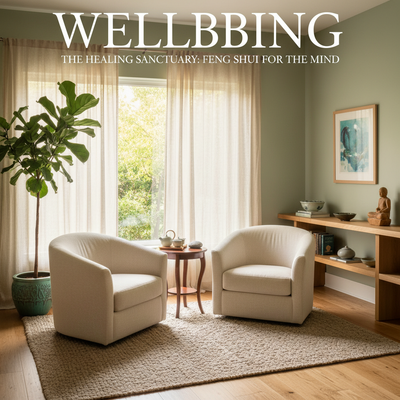There's something special about a bedroom tucked under the roof. The angled walls of an attic or loft space feel cozy, unique, and interesting. But for many people, this romantic feeling soon turns into a strange sense of unease. You might find that you don't sleep as well or feel a constant pressure you can't explain. This brings up an important question many homeowners ask: are sloped ceilings bad feng shui?
The answer has some complexity but is hopeful: while sloped ceilings do create specific energy problems, they can be completely fixed. They are not a "curse" on your home, but rather a design feature that needs careful balancing. With the right knowledge and tools, you can change a potentially draining space into a supportive and peaceful sanctuary.
This guide will walk you through the complete process. We will first look at why sloped ceilings disrupt energy. Then, we'll identify the specific effects this can have on your life. We will provide a detailed look at different ceiling types and, most importantly, offer nine powerful and practical solutions. Finally, we'll show you a real example of how these ideas created a life-changing transformation.
Why Slopes Disrupt Qi

To understand the problem, we first need to understand the idea of Qi (pronounced "chee"). In feng shui, Qi is the vital life force energy that flows through everything, including our homes and our bodies. For the best health, energy, and well-being, Qi should flow smoothly and gently, like a winding stream.
A sloped ceiling, however, disrupts this ideal flow. It creates what feng shui masters call Sha Qi, or oppressive energy. This happens for two main reasons, a principle long-recognized in classical Feng Shui concerning oppressive structures.
Suppressed Qi Flow
Imagine holding a large board at an angle over your head. You would instantly feel a sense of pressure and being trapped. Energetically, a sloped ceiling does the same thing. The angle literally presses down on the energy field of the room, squeezing the Qi. This heavy, stuck energy can make the room feel stuffy and the atmosphere burdensome, even if the physical space is large.
Imbalance and Instability
A flat, level ceiling provides a sense of stability and balance. A sloped ceiling, by its very nature, is uneven. This architectural imbalance can translate into a subconscious feeling of instability and insecurity. Your body and mind are constantly, subtly trying to adjust to the uneven "sky" above you, which can be deeply unsettling, especially during the vulnerable state of sleep.
- Suppressed Energy: The angle creates downward pressure.
- Uneven Flow: Qi is forced to move unevenly, creating imbalance.
- Psychological Pressure: The slant creates a subconscious sense of being confined.
Effects on Your Well-being
This disruption of Qi isn't just a theoretical idea; it shows up in real, concrete issues that can affect your daily life. When the energy in your most personal space—the bedroom—is suppressed, it can have ripple effects across your health, relationships, and personal growth.
Restless Sleep and Tiredness
This is the most common complaint from those sleeping under a sloped ceiling. The downward pressure placed on your personal energy field all night long can prevent you from entering a deep, restorative state of rest. This can lead to tossing and turning, vivid or stressful dreams, and waking up feeling more tired than when you went to bed. Your body simply cannot fully relax and recharge under this constant energetic weight.
Increased Stress and Worry
Living under a constant, though subconscious, pressure can significantly increase feelings of stress and worry. The oppressive Qi can make you feel overwhelmed by daily tasks, mentally "stuck," or as if you're carrying a heavy burden. The bedroom should be a place where you release the day's stress, but a sloped ceiling can accidentally create an environment that makes it worse instead.
Problems in Relationships
When a sloped ceiling is positioned over a bed shared by a couple, it can introduce inequality and tension into the relationship. The person sleeping on the side with the lower slope often feels more of the oppressive energy. This can show up as one partner feeling "smaller," less heard, or more burdened in the relationship, creating an imbalance that can lead to arguments and a lack of harmony.
Blocked Opportunities and Career Stagnation
Your bedroom represents your innermost self—your foundation for rest and renewal. When the energy in this space is suppressed, it can translate to a feeling of being limited in other areas of your life. This can show up as career stagnation, a lack of creative inspiration, or a sense that you are unable to move forward toward your goals. The heavy energy can stifle growth and block the flow of new opportunities.
Analyzing Your Ceiling Type
Not all sloped ceilings are the same. To apply the most effective solutions, it's important to first diagnose the specific architectural style of your room. A more precise understanding allows for a more targeted and successful solution, moving you from being a passive reader to an active participant in harmonizing your space.
The Steep A-Frame
The Challenge: This symmetrical design, common in attics and chalets, creates two distinct issues. The sharp peak in the center can form a "cutting" energy, like a knife edge, while the steep slopes on both sides create heavy pressure. It can feel both sharp and oppressive at the same time.
The Focus: The primary goal is to soften the sharp central ridge and energetically lift the heavy pressure coming down the sides.
The Single-Slope (Shed)
The Challenge: A single-slope ceiling creates a significant energetic imbalance. Qi naturally "slides" from the high side down to the low side, pooling heavily in the lower half of the room while leaving the higher half feeling depleted and unstable.
The Focus: The key is to create balance across the entire room. Avoid placing the bed or primary work area under the lowest point and focus on lifting the energy on the low side.
The Low-Hanging Slope
The Challenge: This is often the most problematic type, where the slope begins low on the wall and doesn't reach a great height. It creates a powerful and immediate sense of confinement and limitation, making the room feel smaller and more restrictive than it actually is.
The Focus: Creating an illusion of height and space is most important. Every solution should be aimed at visually and energetically pushing the ceiling up and expanding the feel of the room.
The Gentle, High Slope
The Challenge: This is the least problematic scenario, often found in rooms where the ceiling begins high up on the wall and slopes gently toward the peak. While the imbalance is less pronounced, it can still subtly direct Qi in an uneven pattern and create a minor sense of instability.

The Focus: Drastic solutions are usually unnecessary. The goal here is gentle redirection and enhancement of the existing Qi flow rather than a major correction.
The 9 Most Effective Feng Shui Solutions
Once you've identified your ceiling type and the challenges it presents, you can implement targeted solutions. Here are nine of the most effective feng shui solutions, ranging from simple adjustments to more involved changes. For each, we explain what to do, why it works, and how to implement it.
-
Bed Placement is Most Important
What: Position your bed so that your head is against the tallest, full-height wall.
Why: This is the number one, non-negotiable rule. Placing your head against the highest wall provides the most stability and support. It takes you out from under the direct downward pressure of the slope, giving you a commanding view of the room and a sense of security.
How: Rearrange your room so the head of your bed rests against the highest solid wall. Make sure you are not in line with the door (the "coffin position"). -
Invest in a Solid Headboard
What: Choose a bed with a strong, solid, and tall headboard, preferably made of wood.
Why: A solid headboard acts as a protective buffer, creating a stable "mountain" behind you. It provides an extra layer of support and separation from the wall, further countering the instability created by the slope above.
How: Select a headboard that is solid, without holes or bars, which can weaken its supportive energy. -
Use Uplighting to "Lift"
What: Place lamps that shine light upwards along the sloped portion of the ceiling.
Why: Light is a powerful form of energy (Yang Qi). By directing light upwards, you are energetically and visually "lifting" the oppressive weight of the ceiling. This simple act can dramatically lighten the feel of the room.
How: Use floor lamps that point up, wall lights that point up, or even place a small lamp on a dresser angled to shine up the slope. -
Paint the Slope Lighter
What: Paint the sloped part of the ceiling a color that is lighter than the walls.
Why: Light colors visually recede, making surfaces appear farther away. Painting the slope a bright, airy color—like a soft white, pale sky blue, or light cream—makes it feel less heavy and imposing.
How: Choose a flat or eggshell finish in a light color for the ceiling. You can paint the taller, vertical walls a slightly deeper shade to ground the space. -
Create a "False Ceiling"
What: Drape fabric or install a bed canopy to create a flat, even surface above your bed.
Why: This is a direct and highly effective solution. A canopy or draped fabric creates a new, level "ceiling" directly above you as you sleep, completely neutralizing the oppressive effect of the slope and creating a cozy, secure nest.
How: Install a four-poster bed with a canopy, or suspend a large piece of light, breathable fabric (like cotton or linen) from the ceiling to create a tent-like effect over the bed. -
Hang a Faceted Crystal
What: Suspend a small, multi-faceted, spherical crystal ball from the center of the slope.
Why: A faceted crystal acts as an energy disperser. It catches the heavy, stagnant Qi, breaks it up, and refracts it around the room in the form of gentle, rainbow light. This helps to circulate and lighten the energy.
How: Hang a crystal (around 30-40mm) on a red string (cut to a multiple of 9 inches) from the approximate center of the sloped ceiling. -
Introduce Upward-Growing Plants
What: Place healthy plants that have an upward growth pattern in the room.
Why: Plants bring vibrant life energy (Wood Element) into a space. Plants that grow upwards, like a Snake Plant (Sansevieria) or a Fiddle Leaf Fig, have a natural lifting energy that helps to counter the downward pressure of the slope.
How: Place a tall, healthy plant in a corner, particularly on the side of the room with the lower ceiling, to help "push" it up. -
Choose Art with Upward Movement
What: Hang artwork that depicts vertical or rising scenes.
Why: The imagery you surround yourself with has a powerful subconscious effect. Art that shows tall trees, soaring birds, mountains, or even abstract vertical lines introduces a visual and energetic sense of upward movement.
How: Select one or two large pieces of art with a vertical orientation and uplifting theme. Place them on the walls to draw the eye upward. -
Use Mirrors Strategically
What: Place a mirror on a wall to reflect a taller part of the room or a beautiful view.
Why: Mirrors can be used to create an illusion of depth and space, making a room feel larger. However, this is a solution to be used with extreme caution in the bedroom.
How: Place a mirror on the tallest wall to reflect the open space of the room. Critically, you must never, ever place a mirror where it reflects you while you are in bed. This can severely disrupt sleep and drain your energy.
Solutions at a Glance
| Solution | Effort/Cost | Feng Shui Principle |
|---|---|---|
| 1. Bed Placement | Low/Free | Command Position, Stability |
| 2. Solid Headboard | Medium | Support (The Mountain) |
| 3. Uplighting | Low/Medium | Lifting Energy (Yang Qi) |
| 4. Light Paint | Medium | Illusion of Space, Lightening |
| 5. Canopy/Fabric | Medium/High | Creating a New, Flat "Ceiling" |
| 6. Crystal Ball | Low | Dispersing Stagnant Qi |
| 7. Upward-Growing Plants | Low/Medium | Lifting Energy (Wood Element) |
| 8. Upward-Movement Art | Low/Medium | Visual & Energetic Lifting |
| 9. Strategic Mirror | Low/Medium | Expanding Space (Use with Caution) |
A Real-World Solution
Theory and principles are essential, but seeing them in action provides true clarity. At THE QI FLOW, we frequently encounter the challenges of sloped ceilings, and the transformations are consistently profound.
The Client's Challenge
We were contacted by a young couple, Mark and Sarah. They had just moved into their "dream home," which featured a beautiful, spacious master bedroom in a converted attic with a steep A-frame ceiling. Despite their initial excitement, they quickly found themselves struggling. Sarah was experiencing severe insomnia, and Mark felt a complete lack of motivation at work. They described the room as feeling "heavy," and found themselves arguing constantly. Their bed, we noted, was pushed into a corner directly under the lowest point of one of the slopes.
Our Feng Shui Analysis
Our team immediately identified the core issue. The bed's position placed them directly under the most oppressive Sha Qi from the steep slope. For eight hours every night, their personal energy fields were being compressed, blocking the body's ability to rest and recharge. This was the direct source of Sarah's insomnia and Mark's career stagnation, and the stressful energy in the room was fueling their arguments.
Our Multi-Layered Solution
We recommended a series of straightforward, layered changes to systematically transform the room's energy:
- Repositioned the Bed: This was the first and most critical step. We had them move the bed so the headboard was centered against the only full-height vertical wall in the room. This immediately took them out of the path of the oppressive Qi.
- Installed Strategic Uplighting: We advised placing two affordable floor lamps that point up in the corners where the slopes met the floor. These lamps shined powerful columns of light up the angled ceilings, instantly making the room feel taller and lighter.
- Recommended a Calming Color Palette: We suggested they paint the two sloped ceiling surfaces a very light, airy off-white. This made the oppressive planes recede visually, further diminishing their energetic weight.
- Added a Solid Oak Headboard: Their previous bed had no headboard. We recommended a solid oak headboard to create a powerful sense of stability and support, anchoring their energy during sleep.
The Result: A Restored Sanctuary
The results were swift and dramatic.
"We couldn't believe the difference a few simple changes made. THE QI FLOW team didn't just give us rules; they helped us understand our space and reclaim our sanctuary. I started sleeping through the night within a week, and the tension between us just melted away. The room finally feels like the retreat we always wanted it to be." - Sarah P.
Within weeks, the entire dynamic of the room—and their lives—had shifted. The space went from being a source of stress to a serene, supportive, and harmonious sanctuary.
Embrace Your Space, Empower Your Life
A sloped ceiling bedroom is not a feng shui flaw to be feared, but an architectural challenge waiting for a mindful solution. It is an opportunity to consciously engage with your environment and shape it to support your well-being.
Remember the most important principles we've discussed. The single most effective action you can take is to optimize your bed placement, moving it under the highest part of the ceiling. From there, layer in solutions that lift the energy—using light, color, and upward-growing elements.
By taking these steps to harmonize your sloped ceiling bedroom feng shui, you are doing more than just redecorating. You are taking a powerful and proactive step toward improving your sleep, reducing your stress, and opening yourself up to a greater flow of positive opportunities in all areas of your life. You have the power to transform your space and, in doing so, empower your life.








0 comments